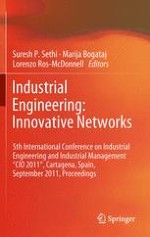The Spanish Conference of Industrial Engineering /Ingeniería de Organización Industrial (CIO) is an annual meeting promoted by Asociación para el Desarrollo de la Ingeniería de Organización/ Industrial Engineers Association (ADINGOR). The aim of CIO is to establish a forum for the open and free exchange of ideas, opinions and academic experiences about research, technology transfer or successful business experiences in the field of Industrial Engineering. The Scientific Committee is composed by 68 international referees and we foresee the attendance of some 200 people from more than 15 countries and following the rotation of venue and organization between various Spanish universities, the 2011 Conference will be the fifteenth National Conference and the fifth International Conference in Cartagena.
During three days the 2011 Conference will include the participation of European and other foreign countries researchers and practitioners that will presenting communications, reproduced in this volume, on a range of topics including:
Production and Operations Business Management
Supply Chain Management
Economic environment
Technological and Organizational Innovation and
Management and Innovation in Education
The Conference on Industrial Engineering (CIO) and its proceedings are an excellent platform for the dissemination of the outputs of the scientific projects developed in the frame of the European, national or regional Research and Development plans.
